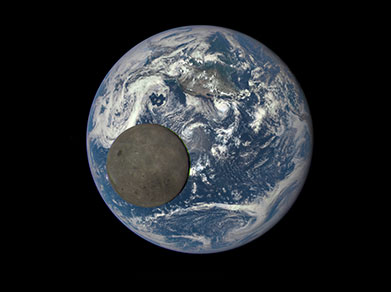
The name Earth is at least 1,000 years old. All of the planets, except for Earth, were named after Greek and Roman gods and goddesses. However, the name Earth is a Germanic word, which simply means “the ground.”
If the Sun were as tall as a typical front door, Earth would be the size of a nickel.
Earth orbits our Sun, a star. Earth is the third planet from the Sun at a distance of about 93 million miles (150 million km).
A day on Earth is 24 hours. Earth makes a complete orbit around the sun (a year in Earth time) in about 365 days.
Earth is a rocky planet with a solid and dynamic surface of mountains, canyons, plains and more. Most of our planet is covered in water.

Earth is a rocky planet with a solid and dynamic surface of mountains, canyons, plains and more. Most of our planet is covered in water.
Earth's atmosphere is 78 percent nitrogen, 21 percent oxygen and 1 percent other ingredients—the perfect balance to breathe and live.
Earth has one moon.
Earth has one moon.
Earth has no rings.
Many orbiting spacecraft study the Earth from above as a whole system—observing the atmosphere, ocean, glaciers, and the solid earth.
Earth is the perfect place for life as we know it.
Our atmosphere protects us from incoming meteoroids, most of which break up in our atmosphere before they can strike the surface.

The first being to travel to outer space was a female part-Samoyed terrier originally named Kudryavka (Little Curly) but later renamed Laika (Barker). She weighed about 6 kg. Image Credit: National Space Science Data Center
Laika the dog was the first Earthling to orbit Earth aboard the Soviet Union's Sputnik 2 in 1957. She did not survive the trip. A few years later, the next two Soviet space dogs—Belka and Strelka—became the first living creatures to return from space alive—paving the way for future human explorers.
Storytellers explore the nature of our planet and possible alternate realities in many books, movies and television shows. The iconic Planet of the Apes film (and many sequels) takes place in a future in which astronauts "discover" a planet inhabited by highly intelligent apes and primitive humans, only to realize later, much to their dismay, that—spoiler alert!—it was Earth all along.
In the long-running and re-booted television series Battlestar Galactica, tired survivors of a war with highly evolved robots called cylons are on a quest to find Earth, a long-lost colony.
In other stories, Earth has been abandoned or destroyed, such as in the Joss Whedon series Firefly or the book and its film adaptation The Hitchhiker's Guide to the Galaxy. In the animated feature Titan A.E., Earth has been destroyed by an alien species, but a well-placed planet builder recreates it and all the species that live on it.
Page Updated: March 22, 2019